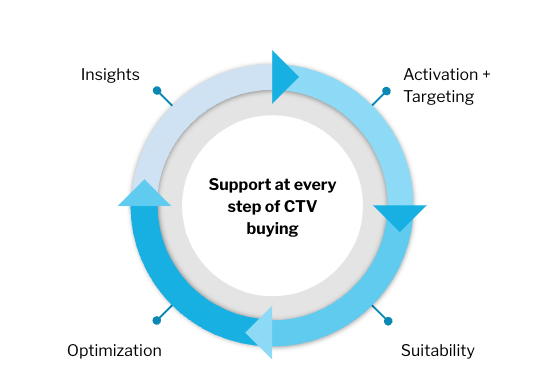Programmatic advertising is a widely-used and fast-growing segment of digital marketing that uses automated tools and real-time bidding to purchase ad space online. Services like Google Marketing Platform, The Trade Desk, MediaMath, and more all allow advertisers to target and segment users based on specific demographics and behavior, and display ads to them across a range of content inventories.
Advertisers use programmatic ad buying techniques to automate the process of targeting and buying ad space online. By automating and speeding up this process, advertisers can target very specific audiences efficiently, and in real time.
Programmatic advertising emerged as a response to traditional advertising methods that were labor-intensive and time-consuming. By automating bidding, ad purchasing and, to some extent, targeting, programmatic minimizes human intervention for the sake of scale and efficiency.
Because of that efficiency and scale, the global programmatic display advertising marketing is projected to reach $2.772 trillion by 2028, with a 31.9% CAGR during that time period. This is primarily driven by the continued growth of digital content platforms, smart device usage, and the increasing digitalization of platforms to support programmatic display advertising.
It’s clear that programmatic advertising has enormous upside and reach in the digital marketing world. But that’s not to say that it doesn’t come with its own downsides. This article will balance the pros and cons of programmatic advertising, and offer tips and tools for getting the most out of this powerful digital marketing technique.
First, let’s step back and explain how programmatic advertising works in a nutshell.
How does programmatic advertising work?
As mentioned, programmatic advertising automates the ad buying process. Functionally, this begins at the demand side platform (DSP). This is where advertisers can set up campaigns, targeting parameters, and creative that will be displayed on inventory across a variety of ad exchanges, private marketplaces, open exchanges, and supply side platforms (SSPs). This could be websites, CTV applications or players, apps, and more.
Targeting through a DSP is based on either behavioral or contextual data about the user or ad inventory. For behavioral targeting, this includes data about user demographics, browsing behavior, interests, geography, and so on. For contextual data, targeting is based on the type of content that the advertising wants their ads to appear alongside.
Once targeting is specified, ads uploaded, and budget set, real-time bidding begins. From here, the programmatic platform bids on CPM, ad impressions and clicks in real-time based on the campaign objectives specified by the advertiser. This takes place automatically and at large scale, minimizing the need for manual interactions.
The pros of programmatic advertising
As mentioned, the core benefits of programmatic advertising relate to the speed, scale, and accuracy at which advertisers can reach the right audiences.
More specifically, here is a list of programmatic advertising benefits that illustrate why its experienced such growth in recent years:
- Time savings. It streamlines the ad buying process, reducing manual effort and saving time. Programmatic advertising requires much less labor to complete transactions, establish pricing and targeting, and conduct ongoing maintenance tasks.
- Enhanced performance. Programmatic advertising offers much more granular targeting and bidding controls than traditional methods. This ensures that marketers can continuously optimize their campaigns through budget and bid adjustments, advanced targeting, and audience segmentation. All of this means that advertisers have the ability to closely monitor and adjust strategies to meet conversion and ROAS goals.
- Data-driven targeting. Whether contextual or behavioral, programmatic advertising works on data-driven targeting that enables highly personalized ad experiences for end users. This increases campaign performance, engagement, and conversion rates.
- Intelligent budget allocation. By automating the ad buying process and optimizing ad placements, programmatic advertising helps advertisers allocate their budgets more efficiently, maximizing ROI.
- Unmatched scalability. Programmatic advertising enables advertisers to reach vast audiences across multiple channels, platforms, and devices, increasing their ads' reach and impact.
- Transparency. Programmatic advertising provides advertisers with detailed insights into their campaigns' performance, allowing for continuous improvement and more informed decision-making. This, however, is not necessarily true across all types of ad inventory. As such, transparency is both a pros and a potential con of programmatic advertising.
- Brand safety. Most DSPs offer advertisers a range of parameters and filters to ensure that their ads appear only on reputable websites and alongside brand-appropriate content. But, like with transparency, the efficacy of brand safety control largely depends on the provider, and the inventory on which the ads are placed.
Now that we’ve established the benefits of programmatic advertising, let's look at some cons.
The cons of programmatic advertising
Programmatic advertising can be an enormous cost center for businesses. Digital ad campaigns can start as low as $500 per month, and scale to a virtually limitless ceiling. Because of that, it’s critical that advertisers understand how programmatic works in great detail. This will ensure that they are able to closely control their ad spend and transparently manage their ROAS.
Understanding how programmatic advertising works means being eyes wide open about its benefits and its potential dangers.
To help with that, here’s a list of programmatic advertising cons that advertisers need to know about:
- Ad fraud. The variety and scale of ad platforms and inventory content available through programmatic advertising makes it susceptible to fraudulent activities like fake impressions, clicks, conversions generated by bots, or placement on made for advertising websites.
- Data privacy concerns. The collection and usage of user data is heavily scrutinized, especially with the introduction of regulations like GDPR and CCPA. As such, advertisers need to ensure their data collecting and targeting strategies remain compliant, especially if they’re using first party data.
- Complexity. Programmatic advertising—at a large scale—involves multiple platforms, intermediaries, and technologies. It can be very difficult to fully grasp the intricacies of this ad tech ecosystem and ensure that spend is cost-effective and is being allocated efficiently.
- An illusion of control. While programmatic ad platforms do provide a great deal of control over targeting, budget, bidding strategy, and more, that control only stretches so far. Advertisers may have less control that they realize over ad placements and formats, which sometimes leads ads to being displayed alongside content that isn’t brand suitable.
- Transparency and brand safety issues. The multi-layered nature of the programmatic advertising space can occasionally result in limited visibility into the true costs, fees, and ad placements. This is especially true when advertising on CTV or OTT platforms, which are still lacking in transparency controls. Knowing how to analyze and interpret campaign performance data is crucial for continuous improvement and optimizing campaign outcomes.
- Ad-blocker usage. There has been a surge in ad-blocker adoption in recent years, effectively shrinking the size of the available audience for programmatic advertisers. Because of that, advertisers are finding inventory targeted via behavioral data is shrinking, thereby increasing the cost of clicks and acquisition.
- Cookie restrictions. The eventual phase out of third party cookies, likewise, means that advertisers will face further challenges with behavioral audience targeting and personalization, requiring them to adapt their strategies.
- Constant change. The programmatic advertising landscape is constantly evolving, making it difficult for marketers to keep up. The ad managers who understand and keep up with the inner-workings of programmatic platforms, and the external forces that are impacting the industry, are best positioned to thrive in this environment.
With a thorough understanding of programmatic advertising, however, ad managers can make informed decisions about ad placements, targeting strategies, and budget allocation. This starts with understanding the tools available to mitigate many of the challenges listed above.
How to mitigate the challenges of programmatic advertising
To distill the points in this article so far, three of the biggest challenges associated with programmatic advertising today are:
- The decaying efficacy of behavioral targeting
- Inconsistent brand safety controls across all content inventories
- Inconsistent transparency across all content inventories
Contextual targeting, layered with transparency and brand safety controls, is perhaps the most effective way to mitigate these challenges.
In a nutshell, contextual advertising serves users with targeted advertising based on terms they’ve recently entered into search engines or website or video content they’ve recently viewed. Tactically, targeting is based on specific contextual categories or keyword clusters that relate to the advertiser’s product or solutions offering. And those same keyword clusters and categories can be used as negative targeting attributes to ensure brand suitability.
By targeting contextually, advertisers can show their ad creatives alongside relevant content to people who have a demonstrable interest in that subject matter.
Through advanced algorithms, contextual technology is able to understand various factors like content on a webpage, local weather and postal code, and even recent news events. These platforms then use machine learning and natural language processing to classify a page in real time to ensure the right ad placements are displayed to the right users, at the right time.
As programmatic advertising becomes more complex, and third-party cookies decay, it will become harder and harder to track users across the internet. This, effectively, diminishes the efficacy of programmatic advertising. Contextual targeting provides a solution to that.
But while contextual targeting and categories offer a solution to decaying efficacy and brand safety issues associated with programmatic advertising, transparency remains an issue for some content inventories. Luckily, there are tools available to help with that too.
CTV transparency in programmatic advertising
A recent study shows that 82% of TV households in the US have at least one connected TV device. But while connected TV is both one of the fastest growing online content segments for programmatic advertisers, there is a significant lack of transparency into where CTV ads run and how they perform.
Some common challenges associated with reporting for CTV programmatic campaigns include:
- Campaign reports showing inconsistent and indecipherable app IDs or bundle IDs
- An inability to tie reporting insights into granular and actionable optimization strategies
- A lack of show-level granularity
- A lack of information about content categories, channel, and quality of production
All of this means that advertisers are effectively spending blind on CTV ad networks. It may be possible that the quality programming they think they’re paying for is actually something as low quality as a screensaver. The problem is that it’s hard to know. And, because of that, it’s also very hard to control.

Peer39’s CTV transparency reporting tool aims to fix that. With it, advertisers can now generate CTV reports that offer the following insights for each campaign:
- Channel
- Show-level
- Content categories
- Production type (user generated versus professional)
- OTT service
- Ad starts
- Ad completes
- Ad completion rate
- Number of ads per show / channel
With this reporting, programmatic advertisers now have the insights they need to make informed targeting and budgeting decisions for their CTV media buying. One less headache when navigating the complex world of programmatic media advertising.
More Posts

Harnessing the Power of Shifting Topics with Peer39's Social Predict
Everyone has favorite internet trends – like Peanut Butter Jelly Time or Chuck Norris Facts. It can be fascinating to see what captures the collective consciousness, seemingly out of nowhere, before vanishing.

Enhancing Retail Campaigns with Peer39’s Contextual Retail Media Categories and Retail Analytics Dashboard - Retail Retail Retail!
Precision targeting has always been paramount in the digital advertising ecosystem, especially for retail brands aiming to engage consumers at critical moments in their shopper journeys. Peer39's pre-bid Contextual Retail Media categories and post-bid data in our Analytics Dashboard provide advertisers with the tools they need to achieve campaign precision while also providing insights to optimize—all without relying on cookies.

Takeaways from CTV Connect 2025: CTV Expectations & Challenges
CTV Connect brought together over 500 decision-makers from across the entire Connected TV ecosystem for a two-day conference in New York City. With so much growth and rapid changes, there were lively conversations, panels, and roundtables around measurement, audience engagement, AI, budgeting strategies, and transparency.

